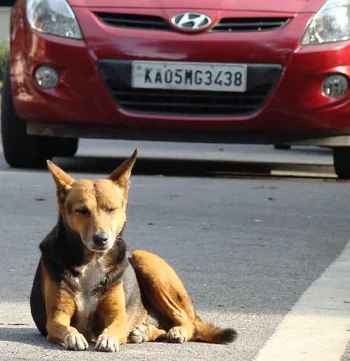The death of two-year old Sandeep a few months ago brought back the debate on the vexing issue of stray dogs in Bengaluru. The city is divided with animal lovers opposing mass culling of strays, with an equally vocal group advocating culling as the only solution.

There’s plenty of food for man’s best friend on the street, what with all the eateries around. Pic: Yogaraj Mudalgi.
Following Sandeep’s death, in July, Rajesh Shukla, 39, an entrepreneur in Bangalore decided to get involved. Apart from consulting US-based forensic experts to get their opinion on Sandeep’s death, Shukla started www.strays.in, to “Provide objective data and statistics about stray dogs in Bangalore”, as he says. “Apart from being inhuman, culling is not scientific. Dogs from other areas quickly migrate to localities with no dogs. It is impossible to catch all dogs and the fight to survive only makes them breed more”, argues Shukla.
On the other side of the debate is Diana Bharucha, 55, who started ‘Stray Dogs Free Bangalore’, an NGO, in 2001 to campaign against stray dogs. Diana says that even though she loves dogs, their population has ballooned out of proportion. “If the population continues to increase, they will revert to pack behaviour and turn wild. They will then start hunting like wild animals, endangering human life.” She says that dogs should have a home and a master, failing which they should be put down humanely as that is the only solution.
“Human life is supreme. One human life is worth more than the lives of all stray dogs put together,” says Diana.

Catching a snooze over the setting sun. Roads are public commons for dogs too, cars or no cars. Pic: YM.
Those against culling argue that most strays feed and live mainly around areas garbage is thrown. “If BBMP implements an effective waste management system, the food available for stray dogs will be limited. This will limit the number of stray dogs in a locality,” says Shukla. He adds that while people give examples of developed countries such as USA or Singapore where stray dog population is almost non-existent, they fail to see that such countries also have clean litter-free surroundings.
Diana, however, feels differently. “When there is limited food, the dogs will have to fight for whatever food is available. This will make them more ferocious,” she says.
What happened to birth control?
Dr Parvez Ahmad Piran, Joint Director of Animal Husbandry, BBMP, estimates the population of stray dogs in the city to be around 300,000. An animal birth control or ABC programme has been implemented by BBMP for some years now with the help of animal welfare organisations (AWOs).
However, ABC has not been completely successful in reducing stray dog population itself.It came under much flak in 2007 after an incident where a child was mauled by a pack of stray dogs in the city. BBMP commissioned Kempegowda Institute of Medical Sciences (KIMS) to conduct an audit of its ABC programme.
The audit report stated that ABC was implemented without any proper planning, monitoring or supervision. It suggested steps such as giving double doses of anti-rabies vaccine to strays, strengthening of BBMP’s veterinary department and compulsory licensing of pet dogs.
Piran says that it takes time for ABC to to show results. He says around 1,16,416 dogs in Bangalore were sterilised in 2010 alone. He says that in the aftermath of Sandeep’s death, the AWOs have been instructed to step up on the sterilisation. “We are targeting sterilising 10,000 dogs every month from now,” he says. “You will be able to see results in three to five years”, he points out.
Was Sandeep really done to death by stay dogs?
On 1st July at 5 45 am, Sandeep, a two-year old’s mutilated body was found near a dumpster in New Yelahanka Town. His right arm and right legs were ripped apart and found next to him. The death was attributed to stray dogs, as police said that the boy was dragged by stray dogs from the basement of a hospital, where he was sleeping next to his father and mauled to death.

Rajesh Shukla, founder of strays.in. Pic: YM.
Convinced that Sandeep’s death was not the result of dog bites, Rajesh Shukla, 39, an entrepreneur in Bangalore decided to investigate it himself a few days after the incident. “How could the police declare with almost no investigation that the death was caused by dogs? Many of the facts indicated the cause of death to be anything but dog bites”, he asks. Shukla says that an average Indian dog weighs 18 – 20 kilos and for it to drag its own weight is an arduous task. “The basement was situated at a lower incline. It would have been impossible for the boy to be dragged without drawing any attention,” he says.
Shukla reached out to US-based forensic experts and sent them images and videos of Sandeep’s body and the surrounding where he was found. The report from the experts, a copy of which is available with Citizen Matters, concludes that although Sandeep’s body did show signs of animal bites, this was only after the boy had died of other causes. The evidence does not point to dog bite or dog attack as the cause of death. “Inadequate attention to detail is apparent in both the autopsy and the police investigation,” says the report.
A Times of India report on 2nd August says that the official post-mortem report released confirms that Sandeep did indeed die of dog bites. However, Dr Parvez Ahmad Piran, Joint Director of Animal Husbandry, BBMP, is undaunted by the report. “My stand has been vindicated by the US-based forensic reports. I had maintained from the beginning that the death was not caused by dogs,” he says. “In 2007-2008, the percentage of dog bites in BMP areas from strays was 52.99%, but in 2009-2010 it has risen to 62% of total bites. How can culling be called a solution when in the immediate aftermath of (major) culling in 2007, the stray dog bites rose by 20% in two years?”, he asks.
Dr Sheila Rao, Trustee of Compassion Unlimited Plus Action (CUPA) one of the AWOs that carries on BBMP’s ABC programme, says that birth control can be effective if done properly. For this, 70% of the population within an area should be sterilized within one mating cycle (6 months), or at least within one year, she says. “If you make an actual check of old Bangalore areas (the original 100 wards) you will find that 90% of the dogs are operated (Clipped ears)”, she adds.
“In, Bangalore, the problem is that many new areas have been added on, and these areas will take maybe another three to four years to be covered”, says Sheila. She also says that some dogs remain uncaught because there are many covered drains that they can disappear into, many vacant sites where dog catching staff cannot enter, many army areas with open fields where catching is difficult.
Diana dismisses ABC altogether and says that crores of rupees is wasted on the ABC programme. She says that for ABC to be effective, 70% of the dogs in a locality should be sterilized within one breeding cycle. ” This is just not possible. The only solution is to put the dogs to sleep humanely,” she says.
Adoption remains a trend
The debate apart, while stray dogs are generally perceived as a threat, some are being adopted by local residents as ‘community dogs’. Ram N K, 43, a resident of 4th Phase JP Nagar says that residents on his street have informally adopted three strays. “A few weeks back, a man tried to steal taps outside the houses at 4 am. The dogs raised an alarm by barking persistently and the neighbours woke up and took the thief to task,” he says.
He adds that a similar incident happened some years ago when the dogs chased thieves who were trying to steal car stereos. “If more people adopt strays and look after them, get them medically treated, it will benefit the residents and the canines,” says Ram.

Pic: YM.
Moved by the plight of stray dogs, especially motherless puppies, Achala Pani, 26, a resident of Malleshwaram, started an NGO ‘Let’s Live Together’ in 2009. The NGO holds adoption camps every month at Sankey Tank in Malleshwaram, where stray puppies which have lost their mothers are put up for adoption for a donation of Rs 500. The puppies are bathed and vaccinated and after eight months can be sterilised. A BBMP pet license is also given at the camps. In two years, more than 200 puppies have been adopted.
“We discriminate strays from bred dogs and think strays are dirty and useless. They are as loyal and loving as any dogs.” She says that instead of calling them strays, we need to think of them as Indian dogs. “If more people adopted strays and not splurge thousands of rupees on bred dogs, there wouldn’t be many dogs on the streets,” she says. ⊕
They need both approaches. Just saying all pets can be sterilized and no culling is not going to solve the problem. There are many strays near my place. I notice that they all have clipped ears. Apart from ferocious territorial fights when a new dog escapes into new territory, and howling at nights, they don’t cause any trouble. They are friendly enough and don’t chase after vehicles or growl at people.
That said, there are those that are ferocious, especially at nights, pretty much imposing a curfew on the streets. How do you deal with them? Do we wait years for them to die away and hope that they did not breed? You need culling selectively.
Pet owners also need to take better care of their pets. I have seen pet dogs left on the street with a collar attacking passers-by and vehicles. How does BBMP deal with such cases? Such dogs should be taken away if on the street and no further licenses should be given to those owners.